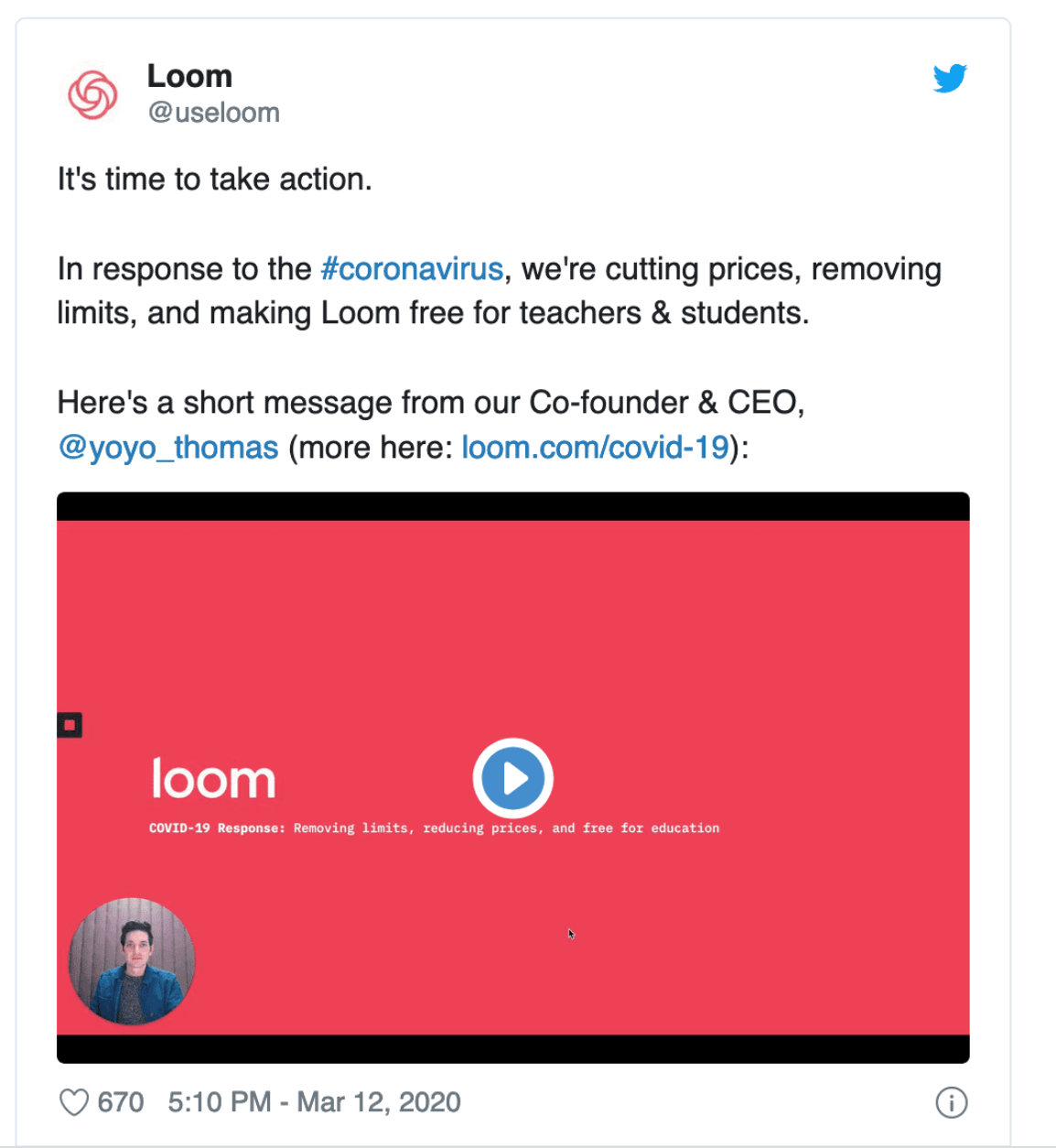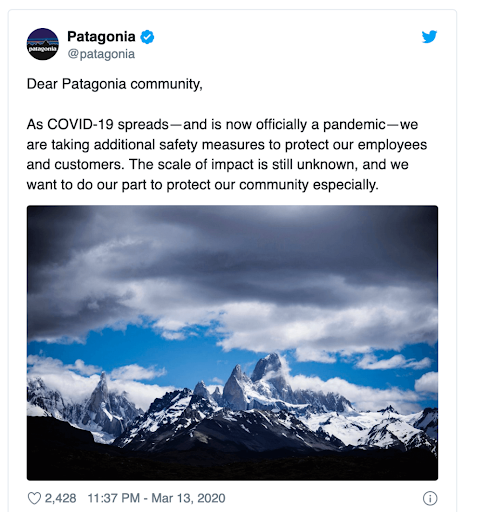As I’m writing this, I can hear my three year old shouting about a lion running loose in the house.
Yep, I’m working from home along with the masses.
And it’s going…well, it’s going.
But we’re all living in a world of incredibly new and raw expectations. Modifications are coming from every which way. From the way we shop. The way we exercise. And of course, the big bone of contention: the way we socialise.
So here we all are.
Of course, we were all socialising online before in our various social channels. But now, in the absence of normality, social platforms are our whole socialising world.
It’s got me thinking about the responsibility us brands have to our social communities.
Ask yourself this: what makes you feel better when you’re worried?
Talking to someone. Hearing positive news. Feeling part of a community.
As human beings, we crave human interaction. We’re built to find safety in numbers.
And as we’re in the midst of strange and scary times with Covid-19, online communities are becoming even more vital as a source for comfort.
We’re all in this together. But with different roles and evolving interplays.
For brands: we have a responsibility to look after our online communities.
Let me be clear: this does NOT mean selling stuff. I’m talking about ‘looking after’ in terms of empathy, with no goal other than human decency.
The shift is very much from ‘what do people want?’ to ‘what do people need?’
And if you’re lucky enough to have built up a community of people who love your products or services, who love your blog or podcast, then you have a responsibility to them in these times.
Your words are going to impact how they think and feel. As with all copywriting, sensitivity is a must, but now, in particular, it should be at the forefront of all communications.
Let me take you through it…
1) REVISIT YOUR SOCIAL PLAN
First up, you need a shake-up of all your planned social posts.
It’s highly likely you’ll take a look at your scheduled content and find some that are at best irrelevant, and at worst wildly inappropriate.
It doesn’t mean you can’t use planned content, but you may need to put a pin in it for now.
For example, big business wins shouldn’t be a song and dance at this moment in time. In times of economic uncertainty, you need to think about how your customers are feeling.
Of course, your loyal customers will be happy that you’re thriving, but some may be going through extremely tough times.
Look ahead for the next three months, removing anything self-promotional, sales-y and insensitive. Replace with posts that focus on how to help your community and offer them value.
And on that note…
2) FOCUS ON HOW YOU CAN HELP
Realistically, most brands simply do not belong in the conversation of Covid-19 as an expert. So suddenly jumping on a bandwagon and posting about it as a source of information could be discordant and unnecessary.
Saying that, most people and companies are affected and impacted.
Whether it’s struggling with remote working or having to suddenly homeschool their children, there are daily challenges.
First up: take a step back.
Look at your brand’s strengths and offerings. What can your area of expertise offer that can help people’s struggles right now?
Premier Inn are offering up extra rooms (of which I’m sure there’s ample), for extra hospital space. Car manufacturers are looking into whether their production lines can transform into ventilation production lines.
You get the gist.
Here’s how Smartsheet, collaborative online worksheet company, did it:
They’re talking in a relatable way that’s directly addressing how they can help make people’s lives easier.
And from Loom, screen recording software company, on Twitter:
It’s a hugely positive step for Loom to be free for students and teachers when they need it the most. And to help consolidate that comfort, they have a short video message directly from their CEO.
Keep asking yourself: what role does my brand play in people’s lives right now? If it doesn’t have a clear role, that’s ok too. The most important thing you can remember is not to force it.
3) USE POSITIVE, CLEAR LANGUAGE
The language you use in your social posts is going to make or break them.
We all know that words have power. So make sure you’re using that power to create a sense of calm and optimism.
When it comes to figuring out what to say when you’re crafting a social message, remember that the details matter. All communication should be clear and relevant, steering clear of assumptions.
WHAT YOU SHOULD DO:
- Keep in your lane. Unless your company is qualified to talk about Covid-19 in an expert way, then keep your opinions quiet. Or even better, silent. There’s already a huge amount of online debate happening, so don’t fuel it.
- Use action words. Using words like ‘do’, ‘create’, ‘feel’ etc will encourage a feeling of proactivity. In times of crisis people need to feel like they’re in control, and active words help them to do this. They’re affirmative and positive.
- Steer clear of jargon. People are inundated with online messages right now, as social media becomes a key source of information. Just keep it simple. Edit your copy where you can, taking out any unnecessary words so it’s crystal clear.
- Ask questions. Encouraging a conversation is important for your brand. Ask how your community is feeling. Ask if there’s anything they need from you right now. Keep the conversation flowing.
THE BIG NO-NO:
Under no circumstances should you use dark humour. Yep, there are some dodgy memes flying around but remember, if you’re prepared to step into the gutter, your loyal community might leave you there.
Use humour if it’s light and appropriate. Kids destroying your home worklife. Lack of penne. No escape from the neighbours’ bad taste in music.
4) KEEP THEM INFORMED
Your community will most likely be confused at a time like this. They could have questions about your operations over the coming weeks, ranging from delivery times to whether you will stay open at all.
Keep your community up to date, giving them enough time to process key decisions and changes wherever possible.
Retail store, Patagonia, put this post out on Twitter on 13th March.
But beyond that, they went overboard on communication. And I don’t mean this in a negative way.
They could have just left the post at the above, but they added in the following:
- We will temporarily close our stores, offices and other operations at the end of business on Friday, March 13, 2020.
- Employees who can work from home will do so. All Patagonia employees will receive their regular pay during the closure.
- We apologize that over the next two weeks, there will be delays on orders and customer service requests.
- We encourage our friends everywhere to take the extra precautions necessary to safeguard their health and that of others.
Although it’s overkill, it will help the community to feel informed and that they’re making every effort to be as transparent as possible.
5) INTERACT…LOTS!
A big mistake brands make on social is to not respond to comments and questions.
If you don’t have a dedicated social media manager, then try to put aside one hour per day to go through your social channels and answer questions.
Of course, if you announce something important, you need to make sure you have someone on the case right away.
Here are some key tips:
- Listen before you talk. People like to be listened to. And it’s important now, more than ever. Before you jump in, make sure you take in everything that’s being said so you can address it calmly and accurately.
- Respond quickly (when possible). According to The Social Habit, 32% of customers expect a response within 30 minutes online. If you can, get in there quickly.
- Personalise conversations. Automated messages have no place on social channels, in my opinion. Try and respond personally to as many comments as you can, making the conversation more intimate and comforting.
- Don’t get involved in heated debates. If the conversation gets heated, don’t join in. There are some tricky topics online right now, so the best thing you can do is acknowledge it calmly, repeat your position and then retreat.
Just keep it conversational, people. No talking ‘at’, only talking ‘to’.
Above all, we need to remember that it’s not what the world can do for us, it’s what we can do for the world.
Where can you help?
How can you help your community?
What problems are your customers facing?
Advice in a nutshell: be calm. Be empathetic. And above all, be human.
Love,
Ella


